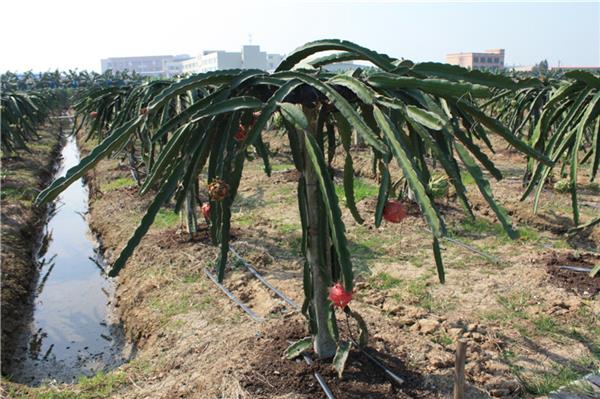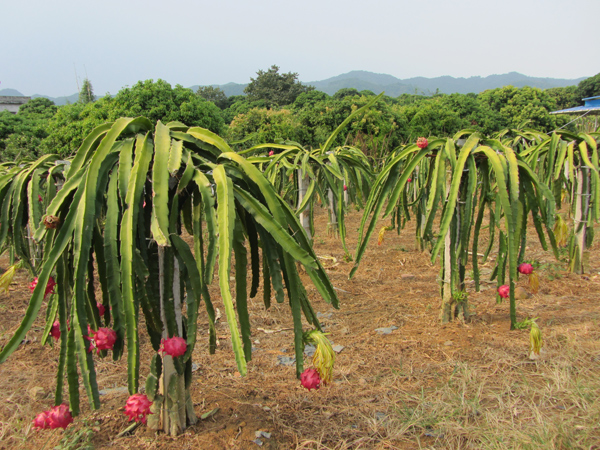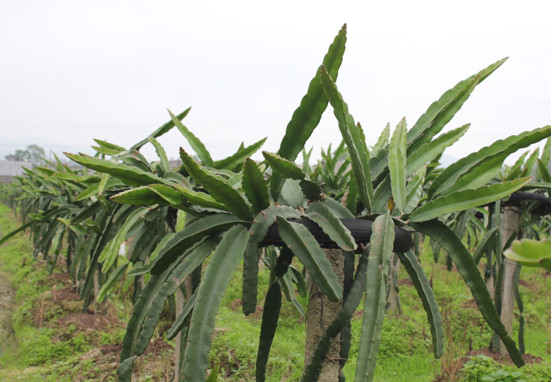[dragon fruit planting method] how to grow dragon fruit
How to water the dragon fruit? What should I pay attention to when watering dragon fruit? Also ask netizens who have experience in dragon fruit planting to help introduce it. The dragon fruit has strong drought resistance, but it does not mean that the dragon fruit does not need watering, so the watering methods and matters needing attention are sorted out, which are listed in detail below for netizens' reference.
Planting method of dragon fruit
1. Site selection and soil requirements: the suitable growth temperature of dragon fruit is 25: 35 ℃, which can be planted in the south of the Tropic of Cancer. Planting requires that the sandy loam with loose, fertile soil and good aggregate structure should be selected, the pH value is 6-7.5 and the drainage is good.

two。 Planting and support: the dragon fruit can be planted all the year round, but it is better from March to November. In the aspect of variety selection, Baiyulong fruit, Pearl Dragon and other excellent varieties can be selected in Meixian area, and grafted seedlings should be selected. Interplanting two varieties can improve the seed setting rate. Cement poles should be erected before planting as a support for the growth of dragon fruit. The specification of the cement rod is 10mm × 10m × 210m. There should be steel bar in the rod body and a symmetrical hole should be pierced at the top so that it can be used to set up the support in the future. The row spacing of the vertical cement pole is 2 meters × 3 meters, with 110 per mu, each cement pole buried 50 meters underground and 160 meters on the ground. 440 seedlings were planted in each mu of garden, and one plant was planted around each cement pole. After growing, the seedlings are tied to the cement pole to make them grow upward.
3. Fertilizer, water and soil management: the root growth of dragon fruit is shallow, and the root growth of 2 to 5 meters under the soil surface is the most active, so fertilizer and water management and soil management should be carried out according to this characteristic. The dragon fruit is more resistant to drought and avoid waterlogging, but its rapid growth still needs sufficient water, so it is necessary to irrigate the root, not the whole plant or field irrigation, which will lead to anoxic death of the root system. Fertilization is mainly based on rotten farm manure, and the best formula is 1 ∶ 2 ∶ 7 withered cake residue, chicken manure and pig manure. The amount of fertilizer depends on growth and soil fertility. Available nitrogen, phosphorus and potassium fertilizers can be applied appropriately at the stage of new branch growth, flowering and fruiting. The plants after hanging fruit are generally fertilized four times in spring, summer, autumn and winter, which can promote germination, spring shoot growth, flowering and fruiting and rejuvenation after fruit picking, respectively. The soil should be kept loose, loose soil can be combined with fertilization and weeding, do not hurt the root system, the aerial root of the aboveground part can be guided to the ground and rooted in the soil by traction, binding and other measures to enhance plant absorption function and promote growth.

4. Shaping and pruning: at the seedling stage, the dragon fruit retains a main branch to grow upward and erases the other side branches. after the seedlings grow 1.5 meters high along the cement pole, the top branches spread in all directions into an umbrella, and a circle is tied with steel wire at the top of the cement pole. used to traction, fix and support plants. After the vigorous growth of the fruit seedlings, the branches of 2 to 3 were selected as hanging fruit branches, and the branches of 1 to 3 were grown upward as vegetative branches and backup fruit branches. After hanging the fruit, the old branches are gradually thinned.
5. Pest control: pitaya is an environmentally friendly green food with fewer diseases and insect pests. The main diseases and insect pests are: rot disease, termites, red and yellow spiders, scale insects and so on, among which the more threatening one is rot disease, which is mainly caused by insect mouth injury or mechanical injury. the treatment is to cut off the disease part or cut open the disease part for drainage in high temperature and sunny days. Other diseases and insect pests can be controlled by spraying corresponding pesticides.

The role of watering dragon fruit in different periods:
The main results are as follows: 1. If there is enough water in the soil before and after germination to the flowering stage, it can strengthen the growth of new shoots, increase the leaf area, enhance photosynthesis, make flowering and fruit setting normal, and lay the foundation for high yield in the same year. In spring drought areas, this irrigation is particularly important.
2. The period of new shoot growth and young fruit expansion is often called the critical period of water requirement of fruit trees. At this time, the physiological function of the fruit tree is the most prosperous, such as the lack of water, the leaves take away the moisture of the young fruit, making the young fruit shrink and fall off.
3. During the period of rapid fruit expansion, this watering can meet the requirements of fertilizer and water for fruit expansion. But it is necessary to master the amount of water this time.
4. Before and after fruit picking and dormant period are in the arid area of autumn and winter, irrigation at this time can store enough water in the soil, contribute to the decomposition of fertilizer, and promote the growth and development of fruit trees in the next spring. After the last batch of dragon fruit is harvested in autumn and winter, it enters the dormant period, at this time, if there is proper irrigation, it can promote the growth of the plant and promote the branches to become fruiting branches as soon as possible.
Matters needing attention in planting dragon fruit
(1) requirements for environment, soil quality and temperature: dragon fruit belongs to tropical and subtropical plants, which is resistant to drought and high temperature, and does not require high soil quality. It can be planted on flat land, hillside and sandy land, but it is best to choose sandy loam soil with rich organic matter and good drainage performance. It is generally not suitable for planting in areas where the temperature is lower than 8 ℃ for a long time in winter.

(2) planting methods: there are many planting methods of dragon fruit, some climb the wall and some set up shed, but column cultivation is the most common, which has low production cost and high land utilization rate. The so-called column type is to set up a cement column or wooden column and plant 3 or 4 dragon fruit plants around the column to let the dragon fruit plant grow upward along the cement column.
(3) planting specification and season: 110 columns can be set up per mu (2.5 m × 2.5 m). According to the calculation of 4 fruit seedlings per mu, planting more than 400 trees per mu can greatly improve the land utilization rate. The dragon fruit can be planted all the year round, because its roots like to be breathable, so it should not be too deep (usually about 3 cm of covered soil). At the initial stage, the soil should be kept moist, otherwise it is not conducive to its growth.
(2) planting methods: there are many planting methods of dragon fruit, some climb the wall and some set up shed, but column cultivation is the most common, which has low production cost and high land utilization rate. The so-called column type is to set up a cement column or wooden column and plant 3 or 4 dragon fruit plants around the column to let the dragon fruit plant grow upward along the cement column.
(3) planting specification and season: 110 columns can be set up per mu (2.5 m × 2.5 m). According to the calculation of 4 fruit seedlings per mu, planting more than 400 trees per mu can greatly improve the land utilization rate. The dragon fruit can be planted all the year round, because its roots like to be breathable, so it should not be too deep (usually about 3 cm of covered soil). At the initial stage, the soil should be kept moist, otherwise it is not conducive to its growth.
- Prev

[money tree rotten root] what about the rotten root of the money tree?
[money tree rotten root] what about the rotten root of the money tree?
- Next

[the propagation method of money tree] the division and insertion of money tree
[the propagation method of money tree] the division and insertion of money tree
Related
- Wuhan Hospital Iron Tree Blooming Result Was Instantly Frightened by the Gardener Master
- Which variety of camellia is the most fragrant and best? Which one do you like best?
- What is the small blue coat, the breeding methods and matters needing attention of the succulent plant
- Dormancy time and maintenance management of succulent plants during dormancy
- Minas succulent how to raise, Minas succulent plant pictures
- What are the varieties of winter succulent plants
- How to raise succulent plants in twelve rolls? let's take a look at some experience of breeding twelve rolls.
- Attention should be paid to water control for succulent plants during dormant period (winter and summer)
- Watering experience of twelve rolls of succulent plants
- Techniques for fertilizing succulent plants. An article will let you know how to fertilize succulent plants.

